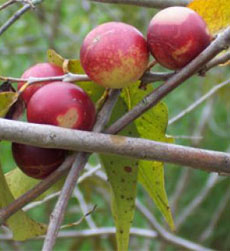PRODUCE: Do You Know Camu-Camu?

The size of grapes, camu-camu are vitamin |
What’s the next superfruit? It’s camu-camu—but you can call it camu, for short.
Camu is the grape-size fruit of a small, shrub-like tree that grows in the swampy basins and flood plains of the Amazon rainforest. As ethnobiologists comb the world for fruits, vegetables, flowers and fauna that may have medical benefits, they’ve discovered that camu contains massive amounts of ascorbic acid—vitamin C. Forget orange juice: No other fruit comes close to having as much vitamin C. It can comprise up to 2% of the weight of the fruit, or about 500,000 ppm. The next closest fruit, from the acerola shrub, contains 16,000-72,000 ppm. And the much larger-size oranges? Just 500-4000 ppm. Camu also contains a host of minerals and amino acids that aid in vitamin C absorption. The flavor is between that of a sour berry and a tart citrus fruit. It is balanced by adding a little sweetener— just as with açaí. Because of the tartness, it is not eaten by the indigenous tribes on whose land it grows.
|
|
| The fruit is picked by tribesmen (and boys) and delivered to area plants where it is flash frozen to preserve it and to help maintain its potency. Then, it travels elsewhere to be turned into juice and powder for health supplements. Açaí travels the same path.
Per ethnobiologist Mark Plotkin in his book Tales of a Shaman’s Apprentice: An Ethnobotanist Searches for New Medicines in the Amazon Rain Forest, camu is not just another superfruit to intrigue knowledgeable folks of the first-world. It can also help to preserve the South American rainforest. While the rainforest is being cut down to provide a living for the locals—to raise cattle and crops—a forest stand (a natural grove in the forest) of camu-camu is worth twice the amount to be gained from razing the forest and replacing it with cattle. Dr. Plotkin believes that the growing interest in camu holds economic promise for the local economy. Dr. James Duke, former chief botanist for the USDA and an expert New World tropical botanist, has studied the fruit and lists a number of possible benefits in his section of the U.S. Agricultural Research Service website. He compared hundreds of fruits and herbs for their effectiveness against various health conditions (also see his website, GreenPharmacy.com). Consumption of camu-camu for its high concentration of vitamin C is highly effective with asthma, atherosclerosis, cataracts, colds, depression, edema, gingivitis, glaucoma, hepatitis, infertility, migraines, osteoarthritis and Parkinson’s Disease. (For treatment of conditions, consult with your healthcare provider.) Now that you know camu-camu, you can see if it’s how you prefer to consume your vitamin C. You can buy camu powder online from Navitas Naturals, which also has camu recipes—Camu Berry Lemonade, Strawberry Pomegranate Margarita (based on ginger tea, not tequila) and more. Find more of our favorite fruits in our Fruits & Nuts Section. |
||
Sacha Inchi said,
January 18, 2011 @ 2:02 am
Camu Camu is is a Peruvian superfruit that is remarkably high in Vitamin C and full of bioflavenoids.